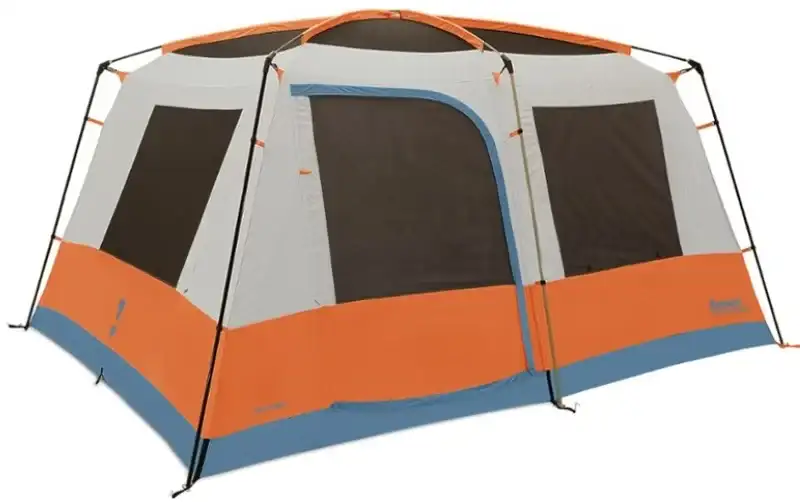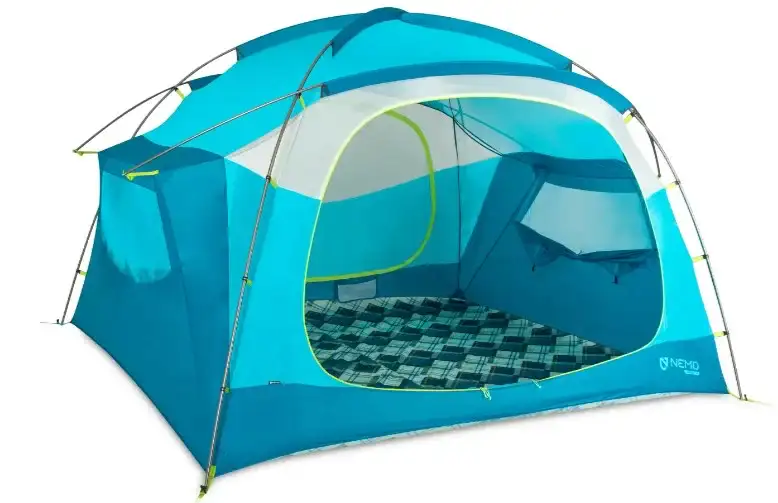Tents’ floors are either bathtub or catenary type, so which is better? Find out here, both types are discussed in detail.
Introduction
Camping and backpacking enthusiasts know that a good tent is a crucial piece of gear. It’s your cozy sanctuary in the wilderness, shielding you from the elements and providing a home away from home.
But have you ever wondered about the different tent floor designs? Typically you have either a bathtub tent floor or a catenary cut. In this article, we’ll delve into the showdown of the “Bathtub Tent Floor vs. Catenary Cut” to determine which one reigns supreme in the wild.

Understanding Bathtub Tent Floors
The bathtub tent floor is like a moat protecting your precious camping castle. This design features raised edges that curl up like a bathtub, keeping water and moisture at bay.
The floor is frequently of a different color than the walls, so you can realize immediately if it has a bathtub floor. The picture below shows this in the case of the Eureka Copper Canyon LX 8 Person Tent where the blue floor raises above the ground.

If everything is properly done, the bathtub floor excels in waterproofing, shielding you from dampness and those pesky groundwater streams eager to invade your tent.
With such a design, the seams that connect the floor and the side walls are well above the ground. This reduces chances for leaks, and it also protects the tent from splashes.
What Is a Catenary Cut Design
In the catenary cut, the floor exactly determines the ground dimensions of the tent. This is not so with the oval bathtub design where you do not know exactly where the edge of the tent is.
One example of a catenary cut floor you can see in the Nemo Aurora Highrise Tent 6 Person, the floor is in a different color as well.

But this design also implies that the seams connecting the floor and side walls are exactly at the edge, and this means more or less on the ground. In other word, chances for leaks are higher.
Comparing Bathtub Tent Floors and Catenary Cut Designs
Weight and Packability
If the floor material is the same as the material of the walls, then I do not see any reason to give advantage to one design over the other. The weight and packability should be the same, any differences should be completely negligible.
But in camping tents, you will frequently have a polyethylene used for the floor. This is a sort of plastic, heavy and thick, and fully waterproof. So if this is a bathtub floor, you will have more of it than what you would have in a catenary cut, and this will increase weight and bulk.
Now, is this important? I think for a car camping tent, this is not a big deal in any case.
On the other hand, tents designed for the trail are not with a polyethylene floors, otherwise you would feel like you’re carrying a small elephant on your back. But indeed, all in all, a catenary cut design would imply a bit of weight reduction.
Waterproofing and Moisture Protection
My guess is that for most of people, the bathtub tent floor armed with its raised edges may look like a better option.
But even a bathtub floor is made of an initially flat piece of fabric. This means that, to make it oval at edges, in its corners you must have some cuts and seams, or just seams, that are partly on the ground. This holds only for the floor that is not a polyethylene, so the seams are taped just like the rest of the tent.
On the other hand, such cuts in a polyethylene floor are not with seams and tapes. This plastic is welded, and such connecting areas are usually even stronger than the rest of the floor and they are also fully waterproof.
The catenary cut design may be more vulnerable to water invasion because you have seams all the way around the tent’s perimeter. But if you’re camping in dry climates or during fair weather, you do not have to think about this at all.
Ventilation and Airflow
When you have such raised edges in a bathtub design, floor vents (if available) are also raised from the ground. So ventilation and airflow may be a bit improved because these openings are more likely to be above some obstacles around.
The catenary cut design may sacrifice a bit of ventilation but can still provide a comfortable living space when paired with proper ventilation systems or careful site selection.
Adaptability to Different Terrains
I have seen some statements about catenary cut adapting better to different terrains.
According to this, a bathtub tent floor, while offering excellent protection against ground moisture, may struggle on uneven surfaces, leaving you with a lopsided and less-than-ideal camping experience.
I must say that I am not fully convinced about this. In fact, I would expect just the opposite.
Final thoughts
In summary, as you navigate the choices between bathtub tent floors and catenary cut designs, I would say that there is no definitive winner. It all depends on how well a particular tent is made.
If seams are fully taped, you will be doing great with any of the two options. So go for the tent that you like and that offers what you need. Focusing on the floor is totally secondary, and I would not pay much attention to it.
But it is fair to say that a polyethylene bathtub floor will likely be without seams on the ground, and this means that chances for leaks are next to none. This is not so with a polyester and nylon bathtub floors, they will have seams in the corners, and those must be taped.
Let me know what you think and if you have questions, there is a comment box below. For more texts of this type please read in the category FAQ. Read in particular my texts about tents condensation and tent pole material.
Bookmark this site and keep as a reference, you will always have new outdoors questions and answers published here.
Leave a Reply